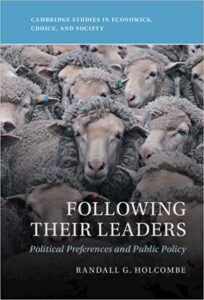As described in my first post in this series, Randall Holcombe’s new book Following Their Leaders: Political Preferences and Public Policy was written to examine how political preferences are formed. To start, Holcombe separates preferences into two different categories—expressive preferences and instrumental preferences. Expressive preferences are, as the name suggests, what we prefer to express. In this case, “express” isn’t limited to what we communicate verbally or in writing, though it does include those. Something is “expressive” when its purpose isn’t to bring about some result, but to reflect a particular attitude. Bumper stickers, yard signs, and tweets are all expressive, but modes of behavior meant to serve as a “show of support” are expressive acts. Instrumental preferences, by contrast, are about the outcomes we prefer.

Our instrumental preferences may or may not align with our expressive preferences. Instrumentally, we might prefer A over B, but we might also prefer to express support for B over A. Consider the case of someone who expresses strong support for the idea of shopping at small and local businesses, but when it’s time to do their shopping will drive right past all the local mom and pop shops and make their way to Target. Their expressive preference is for local shopping and small business, but their instrumental preference is for big box retail stores.
There are many reasons why our expressive preferences may not align with our instrumental preferences. Some preferences feel more virtuous to express—it just feels better to express support for small local businesses than for giant retail corporations. Or our expressive preferences could be formed by peer pressure—you might receive social opprobrium if you outwardly express that big box retailers are a better deal than local shops. Whether we go with our expressive or instrumental preferences will be context dependent, particularly when it comes to market activity and political activity:
Moreover, we shouldn’t underestimate the importance people place on satisfying their expressive preferences:
When our expressive preferences don’t align with our instrumental preferences, and when fulfilling our expressive preferences comes with no instrumental cost, we would expect people to indulge in their expressive preferences. This is why someone might put up yard signs on the importance of supporting local business, and nod sagely along with their friends who express the same idea, yet still drive to Target when it comes time to do their shopping. In the former cases, the expressive preference is cheap, but in the latter case, fulfilling that preference is costly.
When acting as voters, Holcombe argues, expressive preferences will win the day. Unlike in markets, where the direct link between what we choose and what we receive makes us likely to favor our instrumental preferences over our expressive preferences, the lack of any such strong link makes engaging in voting or other political activity likely to be driven by our expressive preferences over our instrumental preferences:
This can explain why voters may vote for a particular outcome, but in practice show little no concern about whether that outcome is successfully achieved. For example, with regards to welfare and transfer programs, Holcombe points out that:
This seems odd. If voters really cared about supporting the needy, and if redistribution in practice doesn’t make the needy much of a priority, why does this state of affairs continue to exist for decades, without a widespread demand for change from voters? Because casting votes is an expressive act, not an instrumental act, and achieving a specific outcome wasn’t the point of the exercise to any given voter:
The disconnect between the common justification for redistribution (helping the needy) and the actual outcome of redistribution (helping the politically powerful) is largely unnoticed by voters because the voters weren’t seeking to create an instrumental outcome to begin with. The point was simply to express a preference for helping the needy—whether or not the needy actually receive help as a result was never really the point.
The difference between expressive and instrumental preferences presents another problem. Recall in the first post where I described Holcombe’s formula for how democracy works—votes are cast to show voter preferences, the votes are aggregated, and a collective choice is made. The internal components of that process, P1 to Pn, are implicitly assumed by political scientists to be instrumental preferences—voters reflecting the outcomes they prefer. But if voters are acting expressively rather than instrumentally, then the output of the voting process doesn’t provide any real information about what outcomes voters actually want:
Thus, voting mechanisms could only provide insight about voters’ preferences for outcomes if voters’ instrumental preferences were identical to their expressive preferences. If voters’ instrumental and expressive preferences aren’t identical, however, then even if it was possible to perfectly aggregate votes in a socially optimal way (which it isn’t) and even if policymakers were entirely incorruptible seraphim exclusively motivated to faithfully serve the public (which they aren’t), elections would still fail to deliver the outcomes the public wants.
However, this disconnect between expressive and instrumental preferences still doesn’t get to the core of Holcombe’s analysis. In the next post, I’ll describe another way of looking at preferences he identifies, and how this influences the way people form their political opinions.


READER COMMENTS
Mactoul
May 9 2023 at 12:59am
Voters generally vote for a person to represent them, they don’t vote for their preferred policies, except for relatively uncommon plebiscites and referenda.
Then there is a disconnect between what their representative stood for when he was seeking votes and what he did or sought to do when in power.
Eg Trump’s actions and inactions on immigration.
And Hitler’s actions. I doubt Germans wanted war but they voted for Hitler who rather wanted one.
Comments are closed.